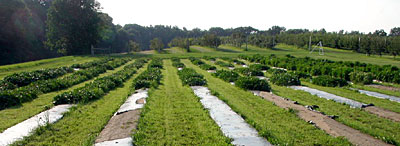 |
| When Becky Grube grew a crop of sweet potatoes under black Biotelo mulch (not yet approved for use on organic farms) and intercropped with mowed ryegrass and white clover, the intercrops interfered with sweet potato growth. Becky Grube photo. |
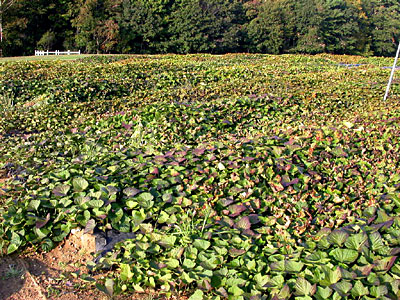 |
| Sweet potatoes grown without a living mulch. Becky Grube photo. |
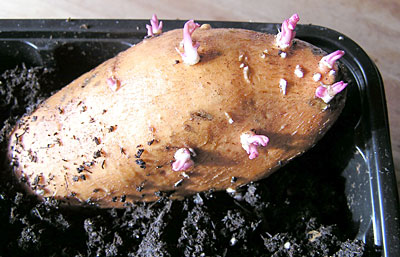 |
| Kept moist and at 75 to 80 F, sweet potatoes sprout – the first step in producing “slips” for growing more sweet potatoes. English photo. |
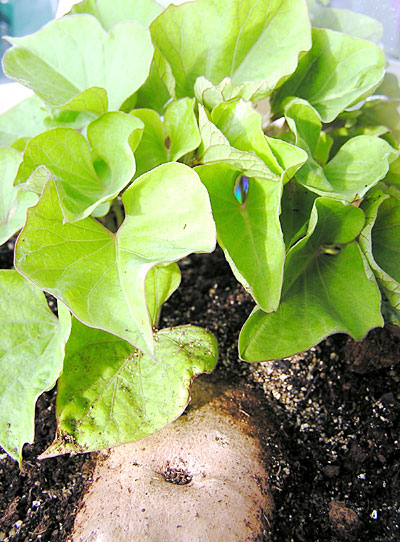 |
| Sprouts grow into shoots that can be cut, rooted in water and transplanted to the field. English photo. |
| Sweet Potato Leaves Are Edible
Mark Guzzi noted at the Farmer-to-Farmer Conference that sweet potato leaves are a delicacy in some cultures, and an Internet search shows that they’re sold at some farmers’ markets in California. This is good news for Maine gardeners, who can grow these as edible houseplants in a south-facing window all winter and harvest the leaves – and take stem cuttings from the plants in May for transplanting out in June. Just watch for aphids indoors … Enjoy sweet potato leaves stir fried in olive oil with garlic and ginger, seasoned with salt or soy sauce, pepper and chili pepper to taste; add them to curry dishes; chop them into stews; or try sweet potato leaf tea. |
Sweet potatoes are being grown successfully in northern New England. They’re delicious, packed with nutrients, attract attention at farmers’ markets, and store up to a year or even longer. At the 2008 Farmer-to-Farmer Conference in Bar Harbor, Becky Grube, UNH Cooperative Extension Vegetable Specialist, Ramona Snell of Snell Family Farm in Buxton, and Mark Guzzi of Peacemeal Farm in Dixmont talked about their experiences with the crop. The information in this article is from that session and from Grube’s publication, “Growing Sweetpotatoes in New Hampshire.”
Sweet potatoes (Ipomea batatas) are in the morning glory (Convolvulaceae) family. They are not related to the Irish potato, which is in the nightshade (Solanaceae) family. While potatoes are tubers (swollen underground stems), sweet potatoes are roots.
Growth Requirements
The sweet potato crop requires 90 to 150 days of frost-free weather. These tropical plants are very sensitive to chilling and grow best if the soil temperature is above 65 degrees F. before planting. Planting dates in Grube’s trials ranged from June 9 to June 22, and harvest dates from Sept. 27 to Oct. 10.
They prefer well-drained loam that is not too fertile and has a pH of 6.5 to 6.8. Over-fertilization causes vigorous leaf growth and long, skinny roots. In heavy clay soils, roots may be small or misshapen and will be hard to dig.
Grube grew sweet potatoes on raised beds (because the soil was poorly drained) under 4-foot-wide black plastic underlain with drip tape. She spaced plants 9 inches apart in single rows. Closer spacing would produce smaller roots, and vice-versa. Snell planted hers under black plastic at 1 foot spacing, poking them in with a water wheel transplanter.
Snell found that some roots grew under the plants while others grew out beyond the planted row.
Guzzi sets plants out in mid-June, 1 foot apart in beds that are about 2 inches high, under black plastic in a very sandy soil, with at least 6 feet between rows. He covers plants with Remay, sometimes for the entire season.
Starting from Slips
Sweet potatoes are started from “slips” (rooted stems). Growers can purchase slips or start their own. Starting slips from roots from a grocery store may be problematic: These may be varieties that do not grow well in our area, and/or the roots may have been treated with sprouting inhibitors unless they were organically grown.
Due to the limited supply of certified-organic slips, organic growers may use nonorganic slips.
To produce slips, place sweet potato roots horizontally in trays of soil about a month before you want to transplant them outside. Cover the roots with 2 inches of moist sand and keep the medium between 75 and 80 degrees F. When sprouts are 4 to 6 inches long, remove them with a twisting tug. The root will continue to produce sprouts. Sprouts can be planted directly in well-prepared ground or placed in a jar of water for a few days to produce a rooted slip and/or to delay planting.
If you purchase slips, specify the shipping date. In Durham, N.H., soil temperatures under black plastic mulch are typically 65 F. by June 1. Cooler conditions may require a later date. Snell asks for her delivery from Steele Plant Co. the first week of June.
Guzzi has been producing his own organic slips for 10 years. When 500 plants from Steele cost only $57, “It’s probably not worth the trouble to grow your own,” he said, “but it’s fun.” He originally got his slips from Dave Kousky of E. Corinth, who started with one variety from his father 30 years ago, which mutated into five types. Guzzi, noting that sweet potatoes “mutate like mad,” has selected for a sixth type.
Guzzi originally put sweet potato roots into a container of potting mix in his greenhouse in early spring, broke off the slips as they developed and planted them in 4-inch pots, later transplanting these to the field – which, in the fall, resulted in a ball of sweet potatoes under the plant, then more roots developing out from the plant–all with a lot of scurf (a fungus that discolors the skin and is harmless but reduces marketability). When he skipped the pot stage, the potatoes had better shapes but still had scurf. He noticed that potatoes produced farther from the plant had less scurf, and he learned that soil organic matter is associated with the fungus. He added more vermiculite, perlite and sand to his starting mix, but still got scurf.
Guzzi’s neighbor told him that her grandmother in Korea raised slips in rice hulls, and the Steele Co. said they raised theirs in oak sawdust. Now Guzzy uses vermiculite and perlite only and has less scurf. In the first week of March, once he’s started his greenhouse furnace, he lays roots horizontally in the moistened media in plastic containers with drainage holes and sets them on boards that make a warm “attic” in his greenhouse, as close to the furnace as possible. “It’s okay to use the smallest, unmarketable sweet potatoes to grow slips,” he said. In June he brings the containers to the field and breaks off and plants the slips directly.
Grube said that slips can also be propagated by taking cuttings of a sweet potato vine. Guzzi said that the eventual yield depends on which section of the vine the cuttings come from.
Home gardeners can place a sweet potato root horizontally in a container of perlite, vermiculite or sand, half buried, and set this very close to a wood stove to induce sprouts to grow; or put the setup in a clear plastic bag and set it on a sunny window; or place the container on top of a water heater.
Mulch and Row Covers
Sweet potatoes respond well to ground-warming black plastic mulch. The sheet of plastic is laid tightly against the soil, and slips are planted into holes cut in the plastic. Good yields are possible without plastic mulch, but the warming mulch extends the growing season by a few weeks, which can increase yields dramatically. Grube noted that the biodegradable Biotelo mulch would make digging much easier, but this mulch is not approved for organic production yet. She grew a crop under black Biotelo in 2007, intercropping with mowed ryegrass and white clover. The intercrops, Grube found, interfered with sweet potato growth.
In Grube’s trials, plants grew faster and better early in the season under slitted row covers and fabric row covers, but overall yields were unaffected. Preliminary results suggest that IRT mulch was not helpful.
As an aside, Snell told of a grower who successfully raised Irish potatoes under black plastic to get an early harvest.
Pests
Deer will browse sweet potato foliage to the ground. This won’t kill the plants but will reduce yields significantly. Since deer have plenty of other food in midsummer, a lightweight, two-strand electric fence may deter them.
Voles love sweet potatoes. Some N.H. farmers say voles have eaten their entire harvest. Grube did not experience significant vole damage in Durham.
Scurf is a soilborne fungus that covers the skin of the root with rough black patches but does not harm the root. Some varieties are more susceptible than others.
Wireworms (click beetle larvae) can be a problem following sod. Japanese beetles and tortoise beetles eat the foliage but don’t seem to be serious pests.
Harvesting and Storing
Sweet potatoes should be dug as late as possible in the fall but before a hard freeze; they tolerate a light frost. Grube suggested harvesting before the soil temperature is below 60 degrees; and avoiding sunscald on the roots. Mowing and removing vines before digging may provide easier access to the roots. She harvested her roots into onion bags the first year, but they got banged up as a result; the second year, in apple boxes, roots were less damaged.
Snell dug her roots by hand with a fork and found that they’re easily damaged. Guzzi digs in late September or early October, between the squash and potato harvests. He mows the tops and then lifts roots with a bed lifter (a piece of a steel I-beam with a cutting blade welded to it).
Harvested sweet potatoes should be cured with adequate ventilation at 80 to 90 F. and at 85 to 90% relative humidity for five to 10 days to heals wounds on their skin, suberize the skin and increase storage life. Grube cured her sweet potatoes for zero, four and eight days in an empty, unheated greenhouse, watering the gravel floor to provide humidity. The day temperature was 85; night, 60. Roots cured for longer than eight days would lose excess moisture.
Store sweet potatoes at 55 to 60 F. and 75 to 80% relative humidity, much like winter squash. Temperatures under 50 can easily damage the roots.
Grube noted that Brix, a measure of sugars, increases during storage. ‘Beauregard,’ for instance, went from about 5.5% soluble solids at harvest to almost 10% after 77 days in storage; ‘Georgia Jet’ went from about 6% to 11%. Curing time did not seem to affect Brix but may have increased storage life. Commercial growers typically cure roots for five to 10 days. “Quality increases dramatically after harvest,” Grube concluded. “To get the best flavor, wait at least three weeks before eating.”
Snell, due to farming pressures, did not harvest her sweet potatoes until a few weeks after a vine-killing frost in 2008, “and they did really well and were immediately sweet.”
Guzzi cures sweet potatoes in the greenhouse until early November, keeping the temperature at 55 degrees at night. Roots on the top of the pile, he noted, get darker than those underneath. He later moves roots into his warm, dry house. In November, Guzzi still had a box of roots from the previous year.
Yield
Grube said to expect a yield of 1.5 to 2.5 pounds per plant. Her yields in 2006 ranged from 0.2 to 2.5 pounds; in 2007, 0.3 to 1.6 pounds. In 2008, ‘Beauregard’ averaged 2.4 pounds per plant, with 3.3 roots per plant; and ‘Covington’ averaged 2.6 pounds per plant, with 3.7 roots per plant. The highest yielding varieties, ‘Beauregard,’ ‘O’Henry’ and ‘White Yam,’ consistently came in lowest in Grube’s taste tests, while ‘Vardaman,’ the lowest yielding variety, came in highest—until 2008, when ‘Covington’ topped the taste tests.
Guzzi gets about 1 pound of roots per row-foot.
Varieties
Sweet potato varieties perform very differently, so Grube recommended testing performance in your situation. Varieties that did best in Durham are:
‘Beauregard,’ which yielded the largest number of quality roots—up to 30 pounds per 12 plants when protected from deer. This variety had average flavor and fairly low Brix readings in Grube’s trials – but consumers recognize this as a typical sweet potato, most like those in supermarkets. Roots varied, with some being big and looking good while others were “rat-tailed.” Slips are widely available. This early variety is the safest bet for commercial production and was the variety grown on about 80% of commercial sweet potato acreage until ‘Covington’ was introduced.
‘Georgia Jet’ is marketed as a short-season variety for northern climates but is very susceptible to cracking, which reduces marketable yield and storability. Cracking may increase with soil moisture level. Its yield potential was high (20 pounds per 12 plants in better areas), it tasted very good, and it’s early. Slips are widely available. This may be a good choice for home use.
‘Japanese’ has white flesh with pinkish skin and a unique, smooth texture. Several tasters say it’s their favorite. “People either love it or hate it,” said Grube. Its size and shape are not uniform, and the roots seemed to be easily damaged during harvest, but the variety may have niche market appeal.
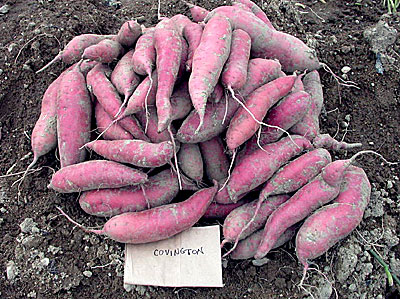 |
| ‘Covington’ sweet potato is replacing ‘Beauregard’ as the commercial cultivar of choice. Becky Grube photo. |
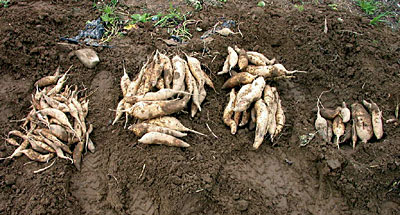 |
| ‘White Yam’ sweet potatoes yielded well but did poorly in taste tests, although some people like the starchier taste of this variety; and it may sweeten somewhat during storage. Becky Grube photo. |
‘O’Henry’ and ‘White Yam’ are high yielding, white-fleshed varieties. ‘O’Henry’ skin tended to green in sunlight and had more blemishes, and ‘White Yam’ was more starchy than sweet but was still delicious.
‘Carolina Ruby’ has very attractive, brilliant orange flesh and deep garnet-colored skin. The skin is unusually rough and thick, and the roots tend to have unusual shapes, but the interior color wins people over. Its flavor is average but disappointing given its color. ‘Carolina Ruby’ yielded well, and its color is useful in a diverse collection.
‘Vardaman’ has outstanding flavor, with the highest Brix ratings (11.5%) in Grube’s trials, but its roots tend to be very small, and yields were low. This variety might do well in a long, dry season. It has light orange skin and deep orange flesh.
‘Covington’ is a new release from North Carolina State University. It has a very uniform shape and size, and it outperformed ‘Beauregard’ in Grube’s trials, but the slips are difficult to get because, even though the variety has replaced ‘Beauregard’ nationally, commercial slip producers have not yet started using this variety.
Grube recommends ‘Beauregard’ and ‘Covington’; recommends with reservations ‘White Yam,’ ‘O’Henry,’ ‘Japanese,’ ‘Georgia Jet,’ ‘Vardaman’ and ‘Carolina Ruby’; and does not recommend ‘Centennial,’ ‘Nancy Hall,’ ‘Bush Porto Rico,’ ‘Darby,’ ‘Tainung 65’ and ‘Hernandez,’ because they either didn’t produce sizeable roots or produced very few extremely large roots. ‘Frazier White’ and ‘Regal’ showed promise but performed inconsistently, and slips are not widely available.
Marketing
Snell said that customer acceptance of sweet potatoes is very high. She got $2 per pound for hers at the farmers’ market when Hannaford was selling them for 79 cents per pound. “If you can stand to grow them and want to fiddle around with them, they’re great,” she said.
Guzzi starts selling sweet potatoes at the farmers’ market in mid-November, when they’re sweet. He charges $2 per pound. “Asian ladies love the white ones,” he observed, adding that the crop is “something exciting to sell in November.”
Farmer-to Farmer attendee Kim Michel said that organic sweet potatoes were selling for $2.49 to $2.69 per pound at smaller stores.
Discussion
Conference participants had no shortage of questions and suggested research topics, including:
Can growers mow the tops and leave the roots in the field to sweeten? This might invite more voles, said Grube. Guzzi suggested that customers might be told how to cure the roots themselves, and he noted that white-fleshed varieties are starchy until the dead of winter. He suggested postponing taste tests until December. He does dig some roots early so that they cure sooner and he can start eating them sooner.
Can growers mow the tops in August and have sweet roots by September? Moisture in the soil may lead to more rot in this case; and roots put on a lot of size in the last few weeks of growth, said one grower.
What is the optimum time to harvest for maximum yield and still have time to cure the roots for market?
How can the vining crop be grown in space-saving ways? Snell’s daughter told her that they’re grown on trellises in the tropics. Ron Poitras of Surry, Maine, said that he grows his vines on a sloped trellis in his hoophouse, and he grows other seedlings between the trellises early in the season. [Ed. note: I’ve grown tubers in large black plastic pots in my hoophouse, letting the vines grow up, over and down along the sides of the pots.]
How do different varieties compare nutritionally – in both the flesh and the skin? Grube has a graduate student studying carotenoid content of roots.
What is the best spacing? Grube suggested 9 inches to 1 foot between plants, with rows 6 to 7 feet on center; or two rows, with plants staggered 18 inches apart, on a 5-foot bed. Guzzi said that rows can be as close as a grower wants if they’re on black plastic. Snell asked if spacing relates to vine growth or root growth. Eric Sideman asked if different varieties should have different spacings. Grube noted that ‘Georgia Jet’ responds better to closer spacing.
Do plants need to be grown on black plastic? Grube knows a grower in northern New Hampshire who does not use plastic. He grows on a very sandy soil, using tine weeding a couple of weeks after transplanting. In cold springs, he covers the beds with Remay to encourage weed growth, then weeds and then transplants. She also noted a study in Connecticut in which plants were grown in sandy, river bottom soil with and without black plastic; no difference in yield occurred. Sideman asked if, without black plastic, the sweet potato vine would root wherever nodes touched the soil, producing a lot of small potatoes everywhere.
What is the best way to dig sweet potatoes? Grube said that a Connecticut grower was using a potato digger that had a digging plate crafted for sweet potatoes; it worked great with single row plantings, but the grower was still working out the kinks for digging double rows. Guzzi’s bed lifter, which he also uses for carrots, digs about 12 to 18 inches deep in the soil.
Does irrigation benefit the crop? Grube said that most growers use drip irrigation. Guzzi uses overhead, and he’s read that watering in the first four to six weeks of the season helps prevent skinny roots.
Should roots be washed after harvest? Guzzi doesn’t wash his until after they’ve cured. Grube said that washing in cold water (under 50 degrees F.) can cause chilling damage, and she suggested trying to sell roots without washing them. Guzzi suggested gently pouring roots into a tub and taking them out, rather than barrel washing. Because they grow on the lightest soil at his farm, mud isn’t caked to them.
What rotations should be used? Sweet potatoes have no pests in common with other crops (scurf is not the same as the organism on Irish potatoes), so sweet potatoes can be rotated with other crops, including potatoes. Grube suggested rotating away from sweet potatoes for two years to minimize scurf. Growing immediately after sod can cause problems with wireworms. Guzzi said he grows them on his sandiest ground, where nothing else will grow, without adding compost. He doesn’t get the best yields, but wouldn’t be using that soil otherwise. Sideman said the crop could be at the end of a long vegetable rotation before the ground is put into sod.
Contact
UNH Cooperative Extension Vegetable Specialist Becky Grube.
Slips
Mapple Farm, 129 Beech Hill Rd., Weldon, New Brunswick, Canada E4H 4N5; 506-734-3361; certified-organic slips in limited quantities
Scott Farms, 7965A Simpson Rd., Lucama, NC 27851; (919) 284-4014; www.scottfarms.com
Steele Plant Co., LLC, 202 Collins St., Gleason, TN 38229; (731) 648-5476; www.sweetpotatoplant.com (Johnny’s Selected Seeds buys its slips from Steele.)
Sand Hill Preservation Co., 1878 230th St., Calamus, IA 52729; (563) 246-2299; www.sandhillpreservation.com
Other sweet potato slip providers are listed on the North Carolina Sweet Potato Commission Web site, www.ncsweetpotatoes.com. Click on “Address Lists” at the top of the page and then “Sweetpotato certified seed producers list.”
– Jean English
